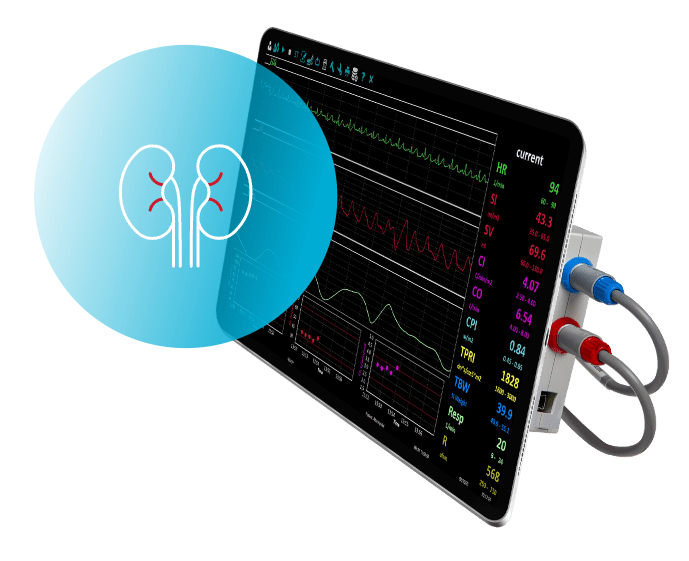Dialysis
NICaS is designed to assist physicians to determine the patient’s body composition and the cause of intradialytic hypertension. Furthermore, the hypotension diagnosis is based on patients’ objective hemodynamic parameters. These parameters provide physicians with a deeper understanding of the total dynamics that affect each patient’s individual hemodynamic status. With NICaS, physicians can more effectively determine the proper dry weight and the dialysis session plan.
Challenges
Determining the patient’s dry weight level: How much fluid do you need to remove during the dialysis session.
Understanding the cause of intradialytic hypotension or hypertension events.
Determining what medication to prescribe in order to keep blood pressure stable during and after the treatment.
Solutions
Accurate dry weight – no guessing.
Easy to determine which medication to prescribe.
Significant decrease in intradialytic hypotension/hypertension events.
Dialysis In Numbers:
80% of end-stage kidney disease patients are expected to receive home dialysis or kidney transplants, By 2025.
88% of patients receive treatment at dialysis centers.
$84B – Medicare’s annual spending on CKD patients.

Related Clinical Markets
Related Clinical Studies
Non-invasive hemodynamic profiling of patients undergoing hemodialysis-a multicenter observational cohort study
Authors: Keren Doenyas-Barak, Marcia H. F. G. de Abreu, Lucas E. Borges, David Pereg, Ilya Litovchik, Shmuel Fuchs and Sa’ar Minha Conclusion: Non-invasive assessment of
The value of non-invasive measurement of cardiac output and total peripheral resistance to categorize significant changes of intradialytic blood pressure: a prospective study
Authors: Yunlin Feng, Yurong Zou, Yifei Zheng, Nathan W Levin, Li Wang Conclusion: This technology provides multi-dimensional insight into intradialytic hemodynamic parameters, which may be
Bioimpedance based clinical decision making in hemodialysis patients decreases episodes of hypotension
Authors: Katzir, Zeev; Petrohno, Oksana; Leiba, Adi; Sharipov, Tatiana; Rubin, Olga; Gaber, Yahya; Hausman, Michel Conclusion: These preliminary results suggest that clinical decision-making based on
The effect of intradialytic volume change on cardiovascular hemodynamics
Authors: Nathan W Levin MD FACP1, Marcia H. F. G de Abreu MD2, Lucas E. Borges MD, Helcio A. Tavares Filho, Rabia Sarwar, MD3Surendra Gupta,
Hemodynamic response to fluid removal during hemodialysis: categorization of causes of intradialytic hypotension
Authors: Nathan W Levin , Marcia H F G de Abreu , Lucas E Borges , Helcio A Tavares Filho , Rabia Sarwar , Surendra
A Novel Hypertension Management Algorithm Guided by Hemodynamic Data
Authors: Barbara Greco, Yossi Chait, Brian Nathanson, Michael J. Germain Conclusion: This pragmatic continuous quality improvement program reveals the feasibility and effectiveness of a hemodynamically
Intradialytic exercise increases cardiac power index
Authors: Brent Momb, Samuel Arlington Headley, Tracey Matthews, Michael J. Germain In conclusion, exercise during dialysis may decrease the likelihood of experiencing ischemic or hypotensive
Comparison of stroke volume measurements during hemodialysis using bioimpedance cardiography and echocardiography
Authors: Michael J. Germain,Jyovani Joubert,Daniel O’Grady,Brian H. Nathanson,Yossi Chait,Nathan W. Levin NICaS SV measurements are similar to and strongly correlated with Echo SV measurements. This
